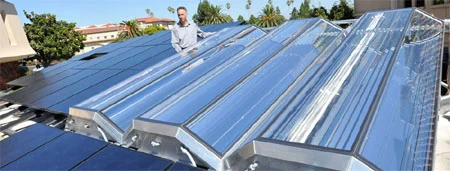We’ve covered a few promising hybrid solar photovoltaic/solar thermal heating systems in the past.
However, Chromasun’s new installation in San Jose, California, is the first hybrid solar electricity/solar thermal cooling system we’ve seen. It is, in fact – according to Chromasun – the world’s first such system, first developed in Australia, currently undergoing testing at a house constructed for the 2007 Solar Decathlon.

The hybrid technology in use at the house builds upon hybrid photovoltaic receiver research and development work Chromasun previously completed in conjunction with The Australian National University and The University of New South Wales.
These hybrid receivers were first developed for installation in standard Chromasun MCT Collectors, then (most recently) mounted for testing and data collection at the 2007 Solar Decathlon House at Santa Clara University in San Jose.
Chromasun’s new MCT Hybrid collectors are simultaneously connected to a Yazaki 5RT single effect chiller and a Sunny Boy inverter. Hot water is supplied by the MCT Hybrid panels to the chiller and 250 Volt DC electricity is supplied to the inverter.
The hot water is then collected in a storage tank, which is also made available for domestic supply and hydronic heating as needed. All told, the system can provide for the home’s electricity, hot water, heat (via radiant, in-floor systems) and cooling needs.
Chromasun believes that this kind of system makes better use of that limited amount of real estate on your roof.
“By using the sun’s energy to generate electricity and then diverting waste heat to drive an absorption chiller, Chromasun can deliver more useful energy into the building than has ever been possible before,” said Peter Le Lievre, CEO of Chromasun, in a statement.
He goes on to note that this is especially useful for facilities with large electricity and cooling loads, as traditional photovoltaic panels may only harvest 15 percent of the sun’s energy, while Chromasun’s new hybrid tech can harvest over 75 percent.
Dr. Vernie Everett from the Australian National University, concurs: “I think the MCT Hybrid project represents the best opportunity that I know for establishing hybrid rooftop concentrators to provide greenhouse neutral energy independence.
“An integrated system comprising several MCT units can provide all the electricity, hot water, space heating, and solar cooling for conventional houses. The range of units developed also has industrial applications for hospitality, food processing, hospitals, and sports centers to name just a few.”
Chromasun expects to launch its new MCT hyrid technology in 2012.






